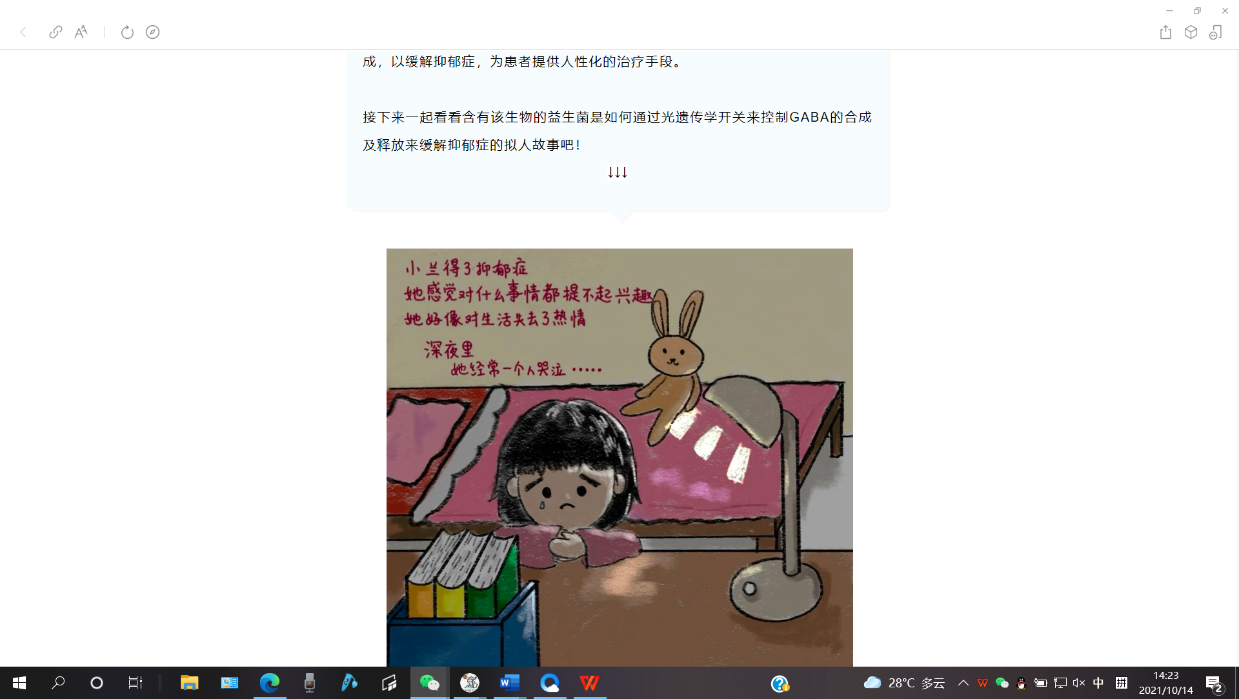
Human Practices
Depression is a serious problem nowadays around the world. Depression among the younger population, especially college students, is getting worse. In China, there was not enough attention on this issue. We would like to tackle this issue from two aspects: 1) promote the understanding of depression through iGEM human practice and 2) explore novel approaches to alleviate depression using synthetic biology. In our human practice part, we would like to focus on the first aspect.
The flow diagram above showed how our human practices evolved over time as we understood more and more about our project. If you want to view more details about our activities, please click on the corresponding box in the flow diagram.
Hospital interview
At the beginning of our project, we mainly used online resources to learn more about depression and its treatment. However, online resources have their limitations and are sometimes misleading. In order to get a correct and better understanding of depression as a major mental health disease, on April 28, PI Shaobin Guo of our FZU-China team and members Huimin Zhang, Shanyu Huang, and Jiale Hong went to the First Affiliated Hospital of Fuzhou Medical University to learn more about the treatment of clinical patients with depression. After a brief introduction of our subject, we interviewed psychotherapists and psychologists who conducted diagnosis and treatment of depression and learned about depression from two aspects: physiological treatment and psychotherapy.
We came to the hospital with the following questions in mind: What problems does China face in the diagnosis and treatment of depression? Because of the differences between China and Western countries, how different are the diagnosis and treatment of depression? Through the interview, we gained the perspectives of doctors who were at the first line of depression diagnosis and treatment for many years and had a comprehensive understanding of depression.
Doctors supported our vision of the project. They said the substances related to attention and judgment included dopamine and γ-aminobutyric acid (GABA), so the underlying logic of our iGEM project was quite good. However, clinical studies on using GABA for the treatment of depression were still rare now. Doctors said at present, almost all the treatments for depression and all the pathologies of depression did not have a sounding clinical basis. Many research results were in the stage of clinical hypothesis, so it was very meaningful for us to do this. The significance of doing research did not necessarily lie in only positive results. Even if we failed, we could block the “road”, by telling other researchers that the development of drugs and treatments in this area were meaningless, then the negative results became meaningful as well. Doctors also mentioned the side effects of current treatments of depression. Our ideal implementation, if successful, would be very helpful to many patients with mild or early-stage depression.
From this half-day visit, we learned a lot about the current situation of depression diagnosis and treatment from actual clinical doctors. We gained a much better understanding of depression, which in turn strengthened our determination to complete the project to contribute to the treatment of depression.
More information about the interview can be found here.




Brochure
Another aspect of our human practice is to draw people's attention to depression and our proposed method of treating depression using a brochure. To make this more interesting to readers of all ages, we created cartoons to make the brochure more interesting and colorful In September, our team member Lingsang Sheng produced our brochure. The brochure introduces the basic information of our project, our picture book, depression, and iGEM. The brochure has been distributed to Fuzhou University students,FLIS students, First Affiliated Hospital of Fujian Medical University and Fuzhou No. 2 Middle School students.


Picture Book
Making science to work is hard, but getting people to understand science is even harder. That is why we created a picture book to explain what our project is and how the biological circuit works to alleviate depression. In September, Danyan
Li produced this picture book. Our picture book is one of the important contents of the cell factory joint picture books.




